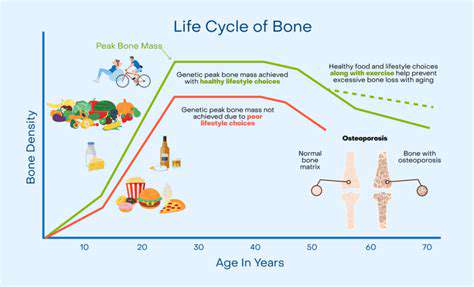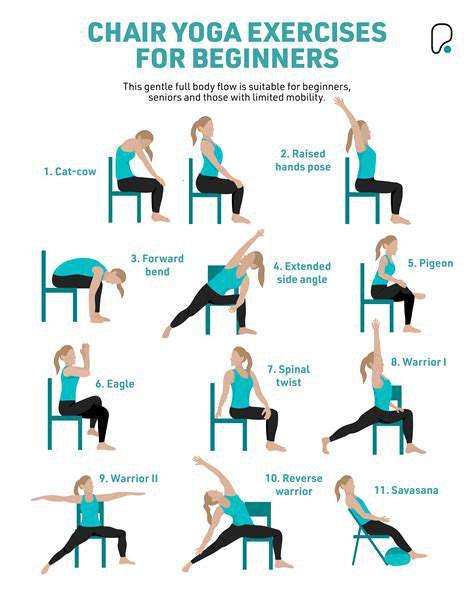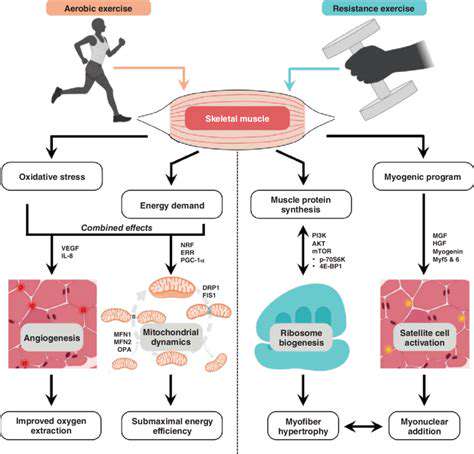Strength Training at Home for Seniors with Osteoporosis: A Safe Guide
Introduction to Strength Training for Seniors with Osteoporosis
Understanding Osteoporosis and Strength Training
Osteoporosis, a condition characterized by weakened bones, is a significant concern for seniors. This weakening makes bones more susceptible to fractures, even from everyday activities. Strength training, however, can play a crucial role in combating osteoporosis by increasing bone density and improving overall strength and balance. Understanding how this works is essential for developing a safe and effective exercise program. It's important to remember that proper form and gradual progression are key to avoiding injuries.
Strength training isn't just about lifting heavy weights. It encompasses a range of exercises that use resistance to build muscle and bone strength. This resistance can come from weights, resistance bands, body weight exercises, or even everyday objects. The goal is to progressively overload the muscles and bones to stimulate their growth and repair, leading to increased density and resilience.
Safe and Effective Exercises for Seniors
When designing a strength training program for seniors with osteoporosis, it's imperative to prioritize safety and gradual progression. Begin with light weights or resistance bands and focus on proper form. Exercises like squats, lunges, and chair-based exercises are excellent choices, as they engage multiple muscle groups and promote balance. It's also important to incorporate exercises that target the core muscles, as this strengthens the body's center of gravity and improves stability.
Consider incorporating seated rows with resistance bands, or standing bicep curls with light dumbbells. Always consult with a healthcare professional or physical therapist to develop a personalized workout plan. They can assess your individual needs and limitations, and help you choose exercises that are safe and effective for you.
Importance of Proper Form and Progression
Maintaining proper form during strength training exercises is crucial for preventing injuries and maximizing results. Incorrect form can put undue stress on joints and muscles, leading to pain and potentially worsening osteoporosis. Focus on controlled movements, engaging the target muscles, and maintaining proper posture throughout each exercise. Start with a lighter weight or resistance level to ensure that you have full control over the movement. A good rule of thumb is to be able to maintain proper form throughout the entire set.
Gradually increase the weight or resistance as you get stronger. This progressive overload is essential for continued improvements in bone and muscle density. Listen to your body and take rest days when needed. Avoid pushing yourself too hard, especially in the beginning. Consistency and patience are key to achieving long-term results in strength training and improving bone health.
Safety Precautions and Modifications for Seniors
Proper Form and Technique
Maintaining proper form is paramount when strength training at home, especially for seniors. Incorrect form can lead to injuries, such as strains and sprains, which can be particularly debilitating for older adults. Focus on slow, controlled movements, ensuring each repetition is executed with precision. Visual aids, such as videos or photos, can be invaluable in ensuring correct form, and consulting with a physical therapist or certified trainer can provide personalized guidance.
Using lighter weights or resistance bands initially is crucial. Gradually increase the intensity as strength improves. This approach minimizes the risk of injury while maximizing effectiveness. Remember, consistency is key; aim for regular workouts rather than infrequent, intense sessions.
Choosing the Right Equipment
Selecting suitable equipment is essential for safe and effective strength training. Consider lightweight dumbbells, resistance bands, and bodyweight exercises. Ensure equipment is stable and secure to prevent accidents. Look for adjustable weights that allow for progressive overload as strength increases. Balance is also crucial, so use supportive mats or exercise platforms if needed.
Prioritize quality over quantity. Invest in durable and well-maintained equipment to ensure safety and longevity. Checking the equipment for any damage before each use is a vital step in preventing accidents.
Warm-up and Cool-down Routines
Adequate warm-up and cool-down routines are critical for injury prevention and promoting overall well-being, especially for seniors. A warm-up prepares the muscles for exercise, increasing blood flow and flexibility. This can involve light cardio, such as walking or arm circles, followed by dynamic stretches that move the joints through a range of motion.
Cool-down exercises help the body return to its resting state, gradually reducing heart rate and muscle tension. Static stretches, holding each stretch for 15-30 seconds, are ideal for cool-down. Prioritizing these routines before and after each workout significantly reduces the risk of muscle soreness and injury.
Modifying Exercises for Seniors
Strength training exercises may need modification for seniors to accommodate physical limitations or health concerns. Start with fewer repetitions and sets, gradually increasing as strength improves. Choose exercises that target major muscle groups, such as legs, back, and chest, for optimal results. Consider seated exercises or modifications to standing exercises, if necessary. For instance, seated rows instead of standing rows.
Progression and Overload
Progressive overload, a key principle in strength training, involves gradually increasing the intensity of workouts over time. This could involve increasing the weight lifted, the number of repetitions, or the sets performed. For seniors, this progression should be gradual and tailored to individual capabilities and limitations. Listening to the body is paramount; rest when needed and avoid pushing through pain.
Monitoring progress is essential for staying motivated and ensuring safety. Track workouts in a journal, noting adjustments and any limitations encountered. This allows for personalized adaptations and ensures consistent growth without unnecessary strain.
Safety Considerations for Seniors
Safety should always be the top priority for seniors engaging in strength training. Consult with a physician before starting any new exercise program. Be aware of any pre-existing health conditions and adjust exercises accordingly. Ensure the workout area is free of hazards, such as loose rugs or cords. Having someone present during the workout is a good idea for added support and safety.
Pay close attention to any pain or discomfort during the workout. If pain persists, stop the exercise and consult a healthcare professional. Listen to your body and prioritize rest and recovery. Using proper technique and gradually increasing intensity are crucial factors in ensuring a safe and effective home strength training program.
Nutrition and Lifestyle Factors for Bone Health

Dietary Habits and Macronutrient Intake
A balanced diet is crucial for overall health and well-being. Consuming a variety of nutrient-rich foods, including fruits, vegetables, whole grains, lean proteins, and healthy fats, is essential for providing the body with the necessary vitamins, minerals, and energy to function optimally. Focusing on whole, unprocessed foods over highly processed options is a key component of a healthy dietary pattern. This approach helps to manage calorie intake and promotes a sense of satiety, reducing the risk of overeating and contributing to weight management.
Paying close attention to macronutrient intake—carbohydrates, proteins, and fats—is also important. Each macronutrient plays a specific role in the body, and an appropriate balance is necessary for optimal function. For example, adequate protein intake is critical for building and repairing tissues, while healthy fats are essential for hormone production and nutrient absorption. Understanding the nutritional value of various foods and the recommended daily intake for different macronutrients will empower individuals to make informed choices and support their overall health goals.
Hydration and Fluid Intake
Staying properly hydrated is paramount for various bodily functions. Water is essential for transporting nutrients, regulating body temperature, and lubricating joints. Adequate fluid intake contributes to optimal digestion, energy levels, and cognitive function. A lack of hydration can lead to fatigue, headaches, and reduced physical performance.
The specific amount of fluid needed varies depending on individual factors such as activity level, climate, and overall health. Consult with a healthcare professional or registered dietitian to determine the appropriate hydration needs for your specific situation. Monitoring thirst cues and carrying a water bottle throughout the day can help maintain adequate hydration levels.
Sleep Hygiene and its Impact
Adequate sleep is vital for physical and mental well-being. Sleep deprivation can negatively impact various bodily functions, including hormone regulation, immune response, and cognitive performance. A regular sleep schedule, creating a relaxing bedtime routine, and ensuring a conducive sleep environment are crucial components of optimal sleep hygiene.
Aiming for 7-9 hours of quality sleep per night is generally recommended for most adults. Prioritizing sleep allows the body and mind to recover, replenish energy stores, and prepare for the next day's activities. Consistent sleep patterns contribute to better mood regulation, stress management, and overall cognitive function.
Stress Management Techniques
Chronic stress can have detrimental effects on both physical and mental health. Managing stress effectively is essential for maintaining overall well-being. Stress-reduction techniques such as mindfulness exercises, deep breathing exercises, and engaging in relaxing activities can help mitigate the negative impacts of stress. Identifying personal stressors and developing coping mechanisms to address them is a crucial step in stress management.
Physical Activity and Exercise
Regular physical activity is essential for maintaining a healthy weight, improving cardiovascular health, and boosting energy levels. Engaging in regular exercise can also contribute to mood elevation, stress reduction, and improved sleep quality. Exercise not only benefits physical health but also enhances mental well-being and overall quality of life.
The type and intensity of exercise should be tailored to individual needs and preferences. Consulting with a healthcare professional before starting a new exercise regimen is recommended, especially for individuals with underlying health conditions. Aiming for at least 150 minutes of moderate-intensity or 75 minutes of vigorous-intensity aerobic activity per week, along with muscle-strengthening activities on two or more days a week, is generally recommended.
Mental Wellness and Emotional Well-being
Maintaining good mental and emotional well-being is integral to overall health and happiness. Cultivating positive self-talk, practicing gratitude, and engaging in activities that bring joy and fulfillment can contribute to a sense of well-being. Regularly connecting with loved ones and participating in social activities also plays a significant role in emotional well-being.
Seeking support from mental health professionals when needed is crucial for addressing mental health concerns. Identifying and managing stress effectively, developing healthy coping mechanisms, and practicing self-care are all critical aspects of promoting mental and emotional well-being.











